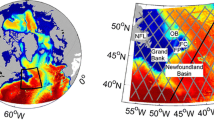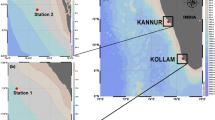Abstract
The Eastern Kamchatka Current (EKC) is the western boundary current of the North Pacific subpolar gyre. Southeast of the Kamchatka Peninsula lies a large anticyclonic eddy, the Kamchatka Eddy (KE). This eddy is quasi-stationary. More generally, the oceanic region east of the EKC contains many eddies, several of them large and long lasting. Using surface currents derived from altimetry, particle tracking and a simple two-dimensional numerical model of fluid flow, we investigate the variability of this eddy field, the generation of eddies in the bays of Kamchatka by the EKC and fluxes of water to and from these bays. Firstly, we recover in our analysis of long-lasting eddies, the main eddies of the region. Among strong eddies, the parity bias favors anticyclones. Our numerical simulations give a possible explanation for the process of eddy creation in the bays of the peninsula and show that the northernmost bay produces most anticyclones. Then, we track forward the water particles from these bays and we determine their fate in the open ocean; southeastward and southwestward trajectories are the most frequent. We also track water particles backward from the KE site; they often drift near the Kamchatka coast, but others drift south of this site and remain there, a priori trapped in other eddies. This study confirms the complexity of mesoscale motions and water exchanges in this region.









Similar content being viewed by others
References
Dawson A (2016) eofs: A library for EOF analysis of meteorological, oceanographic, and climate data. J Open Res Soft 4(1):e14. https://doi.org/10.5334/jors.122
Hannachi A, Jolliffe IT, Stephenson DB (2007) Empirical orthogonal functions and related techniques in atmospheric science: a review. Int J Clim 27(9):1119–1152
Isoguchi O, Kawamura H, Kono T (1997) A study on wind-driven circulation in the Subarctic North Pacific using Topex/Poseidon altimeter data. J Geophys Res Oceans 102(C6):12457–12468
Isoguchi O, Kawamura H (2002) Wind-driven circulation in the Subarctic North Pacific using altimeter data. J Earth Syst Sci 111(3):267–279. https://doi.org/10.1007/BF02701973
Isoguchi O, Kawamura H (2003) Eddies advected by time-dependent Sverdrup circulation in the Western Boundary of the Subarctic North Pacific. Geophys Res Lett 30(15):1–4. https://doi.org/10.1029/2003gl017652
ISS Crew (2012) Photo of ice floes along the Kamchatka coastline. NASA Earth Observatory, https://earthobservatory.nasa.gov/images/77589/ice-floes-along-the-kamchatka-coastline
Khrapchenkov FF (1991) Peculiarities of hydrological structure in Avachinsky Bay in winter 1989. Okeanologiya 31(6):949–954. [in Russian]
Le Vu B, Stegner A, Arsouze T (2018) Angular momentum eddy detection and tracking algorithm (ameda) and its application to coastal eddy formation. J Atmos Ocean Tech 35(4):739–762
Liu Y, Dong C, Guan Y, Chen D, McWilliams JC, Nencioli F (2012) Eddy analysis in the subtropical zonal band of the North Pacific Ocean. Deep Sea Res Part I: Oceanogr Res Papers 68:54–67
North GR, Bell TL, Cahalan RF (1982) Sampling errors in the estimation of empirical orthogonal functions. Monthly Weather Rev 110:699–706
Prants SV, Budyansky MV, Lobanov VB, Sergeev AF, Uleysky MYu (2020a) Observation and Lagrangian analysis of quasi-stationary Kamchatka Trench eddies. J Geophys Res (Oceans) 125 (6):e2020JC016187. https://doi.org/10.1029/2020JC016187
Prants SV, Budyansky MV, Uleysky MYu (2020b) Odyssey of Aleutian eddies; unpublished manuscript submitted to J. Geophys. Res. (Oceans)
Prants SV, Lobanov VB, Budyansky MV, Uleysky MY (2016) Lagrangian analysis of formation, structure, evolution and splitting of anticyclonic Kuril eddies. Deep-Sea Res Part I-Oceanogr Res Papers 109:61–75
Prants SV, Uleysky MYu, Budyansky MV (2017) Lagrangian oceanography: large-scale transport and mixing in the ocean. Springer, Berlin, p 271
Quadrelli R, Bretherton CS, Wallace JM (2005) On sampling errors in empirical orthogonal functions. J Clim 18:3704–3710
Rogachev K, Shlyk N, Carmack E (2007) The shedding of mesoscale anticyclonic eddies from the Alaskan stream and westward transport of warm water. Deep-Sea Res Part I-Top Stud Oceanogr 54 (23-26):2643–2656
Roullet G (2017) Fluid2d documentation. https://pagesperso.univ-brest.fr/roullet/fluid2d
Solomon H, Ahlnas K (1978) Eddies in the Kamchatka Current. Deep Sea Res 25:403. https://doi.org/10.1016/0146-6291(78)90566-0
Stabeno PJ, Reed RK, Overland J (1994) Lagrangian measure- ments in the Kamchatka Current and Oyashio. J Oceanogr 50:653–662. https://doi.org/10.1007/BF02270498
Vermeer M, Rahmstorf S (2009) Global sea level linked to global temperature. Proc Natl Acad Sci 106(51):21527–21532
Yasuda I (2000) Coauthors Cold-core anticyclonic eddies south of the Bussol Strait in the Northwestern Subarctic Pacific. J Phys Oceanogr 30(6):1137–1157
Yeo S-R, Kim K-Y (2014) Global warming, low-frequency variability, and biennial oscillation: an attempt to understand the physical mechanisms driving major ENSO events. Clim Dyn 43:771–786. https://doi.org/10.1007/s00382-013-1862-1
Zhabin IA, Lobanov VB, Watanabe S, Wakita M, Taranova SN (2010) Water exchange between the Bering Sea and the Pacific Ocean through the Kamchatka Strait. Russ Meteorol Hydrol 35(3):218–224
GEBCO Compilation Group (2019) GEBCO 2019 Grid (https://doi.org/10.5285/836f016a-33be-6ddc-e053-6c86abc0788e)
Acknowledgements
This work was achieved in partial fulfilment of A. L’Her and M. Reinert, students for an MSc degree in Physical Oceanography at UBO. The MSc studies of M. Reinert are supported by the MOPGA grant of the French government. The work of SP was supported by the Russian Science Foundation (project no. 19-17-00006).
Author information
Authors and Affiliations
Corresponding author
Additional information
Responsible Editor: Tal Ezer
Publisher’s Note
Springer Nature remains neutral with regard to jurisdictional claims in published maps and institutional affiliations.
Appendix: North’s rule of thumb for the EOFs
Appendix: North’s rule of thumb for the EOFs
In this appendix, we present the first four EOFs for the sea surface height anomaly (or sea level anomaly, SLA; see Fig. 10). The error bar of the fourth EOFs is larger than the difference between the fourth and fifth eigenvalues. Thus, according to North et al. (1982), we do not retain the fourth EOF nor the following. This fourth EOF spatial pattern contains dipolar eddies (the association of a cyclone and of an anticyclone) which have to be interpreted physically.
Rights and permissions
About this article
Cite this article
L’Her, A., Reinert, M., Prants, S. et al. Eddy formation in the bays of Kamchatka and fluxes to the open ocean. Ocean Dynamics 71, 601–612 (2021). https://doi.org/10.1007/s10236-021-01449-w
Received:
Accepted:
Published:
Issue Date:
DOI: https://doi.org/10.1007/s10236-021-01449-w





